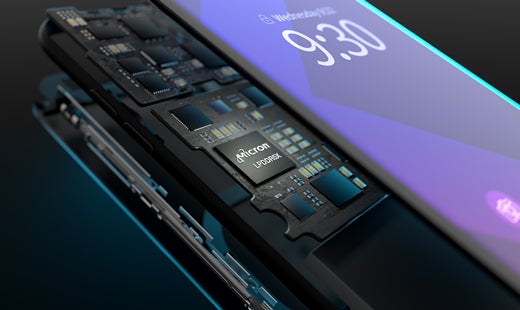Micron's most advanced mobile memory, LPDDR5X, is validated by MediaTek for Dimensity 9000 5G

Yesterday we told you that MediaTek had introduced the Dimensity 9000 5G, the first chipset manufactured by TSMC using its 4nm process node. This chip will deliver improved performance and improved energy efficiency. U.S. memory firm Micron Technology announced yesterday that the company will be supplying MediaTek with its low-power double data rate 5X (LPDDR5X) DRAM for the Dimensity 9000 5G chipset (samples have already been shipped).
U.S. based Micron has its new LPDDR5X DRAM validated by MediaTek's Dimensity 9000 5G
Micron's 5X (LPDDR5X) DRAM is built on its first-to-market 1α (1-alpha) node which it first announced back in January. The advanced mobile memory is designed for flagship smartphone models and Micron says that it "allows the smartphone ecosystem to unlock the next wave of data-intensive applications powered by artificial intelligence (AI) and 5G innovation." Micron has been on a roll releasing a number of industry-first components including LPDDR5, 1α-based LPDDR4X, 176-layer NAND-based UFS 3.1, and uMCP5 solutions.

Micron's LPDDR5X DRAM will be used MediaTek's Dimensity 9000 chip
MediaTek's Dimensity 9000 5G will be the first chipset to support LPDDR5X memory, which delivers industry-leading peak bandwidth of 60 gigabytes per second for top-shelf, high-end flagship smartphones. Micron says that the delivery of LPDDR5X to its partners combined with MediaTek’s validation" paves a path to broad market adoption."MediaTek's validation should lead to adoption by the "broad market." Peak LPDDR5X speeds weigh in at 8.533 Gb/s to deliver up to 33% faster performance than previous-generation LPDDR5.
Raj Talluri, senior vice president and general manager of Micron’s Mobile Business Unit, says, "Innovating cutting-edge smartphone experiences requires memory technology built to address the massive bandwidth demands of the mobile market. Our collaboration with MediaTek to validate the world’s most advanced mobile memory empowers the ecosystem to deliver the next wave of rich mobile features enhanced by 5G and AI."
Micron says that advanced chipsets, like MediaTek's Dimensity 9000 5G, require the high data rates provided by LPDDR5X to produce seamless multitasking and for AI, Augmented and Virtual Reality, and immersive graphics. JC Hsu, corporate vice president and general manager of the Wireless Communications Business Unit at MediaTek, stated that "Our mobile customers are increasingly demanding higher bandwidth to support complex, data-hungry applications built for the 5G era."
Hsu added that "With its superfast mobile memory, Micron’s LPDDR5X squarely meets this challenge for flagship devices. The Dimensity 9000 will be the first to support this critical advancement of LPDDR5X, giving carriers and device-makers the capabilities they need to deliver incredible 5G experiences at the flagship tier."
MediaTek is now the top AP chipset manufacturer in the world
MediaTek's chips are built by the world's leading global foundry, TSMC. The latter counts among its customers some big name tech firms including Apple, AMD, NVIDIA, and more. Up until the U.S. changed its export rules to prevent Huawei from receiving chips made by foundries using U.S.-based technology, the Chinese manufacturer was TSMC's second largest customer behind only Apple.
Qualcomm's Snapdragon chipsets are arguably MediaTek's largest competition. We wouldn't include the Exynos chips in this battle since Samsung's AP chipsets are not often found on non-Samsung phones. And we would also rule out Apple's A-series chipsets since those are exclusive to Apple-made devices. Over the last year, MediaTek has taken over the top spot among chip designers.
During the second quarter of 2020, according to Counterpoint, Qualcomm was the leading shipper of AP chipsets responsible for 32% of the market. MediaTek was second with a 24% slice of the global AP pie. For the second quarter of 2021, Mediatek took over the lead with a stunning 43% market share. Qualcomm's share during that quarter dropped down to 24%.
Huawei, which shipped 15% of the application processors delivered during last year's second quarter, saw its share drop to 3% last year thanks to the U.S. ban.
Follow us on Google News












Things that are NOT allowed:
To help keep our community safe and free from spam, we apply temporary limits to newly created accounts: